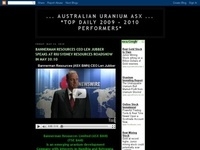Published on Thursday Nov 18 2010


The spot price is up 46% to $59.50 per pound of uranium U3O8 and term price is up 7% to $62 per pound since lows in late June 2010 according to Ux Consulting. Both prices are now at their year highs. This is the highest spot uranium price that we have seen since Sept. 15, 2008, and the credit crunch.
Applying higher prices typically had a positive impact to our net asset values and target prices. We leave our 2011 spot and term price assumptions at $65 per pound of U3O8 but are increasing our 2012 and 2013 forecasts to $70 per pound and $75 per pound, respectively, up from $65 per pound and $60 per pound.
Our 2014 assumption has increased to $67 per pound from $60 per pound and our long-term price has increased to $65 per pound from $60 per pound. We maintain our "pounds in the ground" value for unmodeled resources at $1 per pound of U3O8 for most companies under coverage, but conceded that we do use from $2 per pound to $8 per pound to value some stocks depending on the deposit's production status, grade or proximity to existing uranium mills. Currently producers trade at an average enterprise value per pound of $6.64, while the developers trade at $4.12.
Investors and utilities are quickly realizing that China's reactor-build program is for real. China expects 70 gigawatt-electric (GWe) of nuclear power by 2020 and perhaps as high as 80 GWe. The World Nuclear Association continues to assume 63 GWe in its well-known uranium supply-demand model. In just the past four months China has signed long-term contracts worth about 133 million pounds with Cameco (ticker: CCJ), [France's] Areva and Kazakhstan, and has an memorandum of understanding with [Australia-based] Paladin Energy. As China's annual requirements approach 40 million to 50 million pounds annually by 2020 -- this amount of fuel might not last three years. Spot market purchases continue -- some industry insiders speculate that about 30 million pounds were purchased since 2009. China has 13 reactors in operation, 23 under construction and 39 planned (not including the 120 proposed). We expect further demand -- well in advance of the expected 2013-2014 supply deficit coincident with the Russian HEU (highly enriched uranium) agreement expiry.
Timing and security of supply are of utmost importance. We remind investors that it's not just the production-demand graph they should be considering. It takes some time to convert U3O8 to UF6 [uranium hexafluoride], enrich the UF6, fabricate fuel pellets and manufacture zirconium alloy fuel bundles before shipping the fuel to nuclear reactors around the world.
Purchases must be done well in advance of delivery of U3O8, which in turn must be well ahead of requirements. And competition for security of supply is getting tighter very quickly. The Chinese are buying aggressively from the producers; Russians are attempting to take over various companie;, Korean, Japanese and French nuclear concerns are becoming fully vertically integrated and are actively seeking fuel by any means (joint ventures, off-take, exploration) for end-users that buy their reactors. India has barely gotten started. And the U.S. who has 104 of the world's 441 reactors, uses 50 million pounds of U3O8 annually, and is essentially nowhere to be seen during what we believe are the early days of this buying frenzy.
Speculators are re-entering the uranium market. Goldman Sachs (GS) owns the commodity. Hedge funds are getting back in. Along with supply disruptions, investor demand was a main driver behind the spectacular spot price run of 2007 -- but this time we expect uranium prices to behave a little more rational. The spot market is larger now, both in terms of volume (44.8 million pounds traded year-to-date versus 20 million pounds in 2007) and market share (20% of total volume year-to-date compared to 8% in 2007).
We have been pounding the table since June 29, 2010. Uranium stocks started moving on July 5, 2010, following the 23 million-pound Cameco-Chinese contract announcement. Now most uranium stocks have more than doubled as producers and developers are up 123% and developers are up 120%.
This report was designed to be less of a uranium supply-demand report and more to provide a guiding hand to what uranium stocks investors should be buying. We have 15 uranium stocks under full coverage and another four in our Mineral Exploration Watch List. In the past two weeks we have seen new money flow into the sector and these generalists are concentrating largely on the producers.
During the first week of November, trading volumes of the producers had already matched the total from October. Some have a rising tide lifts all boats approach -- but we believe that investors should continue to focus on companies with production or good projects and near-term milestones.
Commodity: Uranium Participation [traded over-the-counter] remains an easy way to get quick exposure to the uranium spot price.
Producers: Paladin remains a preference over Uranium One [traded in Toronto], although the latter provides near-term incentive.
Visit my other site Australian Uranium Investing
 Australian Uranium News - Research
Australian Uranium News - Research

No comments:
Post a Comment